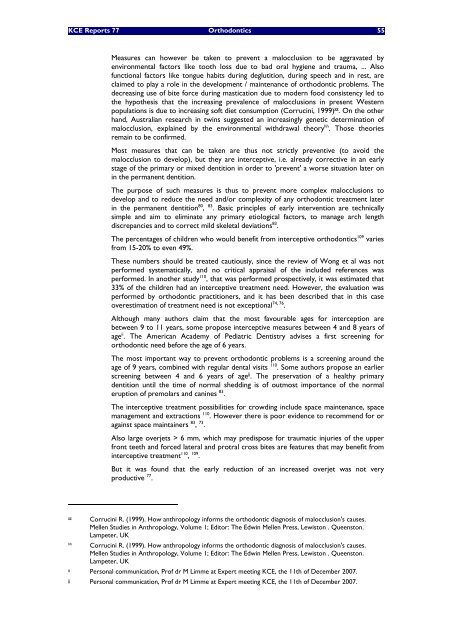The report is available in English with a Dutch summary - KCE
The report is available in English with a Dutch summary - KCE
The report is available in English with a Dutch summary - KCE
You also want an ePaper? Increase the reach of your titles
YUMPU automatically turns print PDFs into web optimized ePapers that Google loves.
<strong>KCE</strong> Reports 77 Orthodontics 55<br />
Measures can however be taken to prevent a malocclusion to be aggravated by<br />
environmental factors like tooth loss due to bad oral hygiene and trauma, ... Also<br />
functional factors like tongue habits dur<strong>in</strong>g deglutition, dur<strong>in</strong>g speech and <strong>in</strong> rest, are<br />
claimed to play a role <strong>in</strong> the development / ma<strong>in</strong>tenance of orthodontic problems. <strong>The</strong><br />
decreas<strong>in</strong>g use of bite force dur<strong>in</strong>g mastication due to modern food cons<strong>is</strong>tency led to<br />
the hypothes<strong>is</strong> that the <strong>in</strong>creas<strong>in</strong>g prevalence of malocclusions <strong>in</strong> present Western<br />
populations <strong>is</strong> due to <strong>in</strong>creas<strong>in</strong>g soft diet consumption (Corruc<strong>in</strong>i, 1999) gg . On the other<br />
hand, Australian research <strong>in</strong> tw<strong>in</strong>s suggested an <strong>in</strong>creas<strong>in</strong>gly genetic determ<strong>in</strong>ation of<br />
malocclusion, expla<strong>in</strong>ed by the environmental <strong>with</strong>drawal theory hh . Those theories<br />
rema<strong>in</strong> to be confirmed.<br />
Most measures that can be taken are thus not strictly preventive (to avoid the<br />
malocclusion to develop), but they are <strong>in</strong>terceptive, i.e. already corrective <strong>in</strong> an early<br />
stage of the primary or mixed dentition <strong>in</strong> order to 'prevent' a worse situation later on<br />
<strong>in</strong> the permanent dentition.<br />
<strong>The</strong> purpose of such measures <strong>is</strong> thus to prevent more complex malocclusions to<br />
develop and to reduce the need and/or complexity of any orthodontic treatment later<br />
<strong>in</strong> the permanent dentition 80 , 83 . Basic pr<strong>in</strong>ciples of early <strong>in</strong>tervention are technically<br />
simple and aim to elim<strong>in</strong>ate any primary etiological factors, to manage arch length<br />
d<strong>is</strong>crepancies and to correct mild skeletal deviations 83 .<br />
<strong>The</strong> percentages of children who would benefit from <strong>in</strong>terceptive orthodontics 109 varies<br />
from 15-20% to even 49%.<br />
<strong>The</strong>se numbers should be treated cautiously, s<strong>in</strong>ce the review of Wong et al was not<br />
performed systematically, and no critical appra<strong>is</strong>al of the <strong>in</strong>cluded references was<br />
performed. In another study 110 , that was performed prospectively, it was estimated that<br />
33% of the children had an <strong>in</strong>terceptive treatment need. However, the evaluation was<br />
performed by orthodontic practitioners, and it has been described that <strong>in</strong> th<strong>is</strong> case<br />
overestimation of treatment need <strong>is</strong> not exceptional 74, 76 .<br />
Although many authors claim that the most favourable ages for <strong>in</strong>terception are<br />
between 9 to 11 years, some propose <strong>in</strong>terceptive measures between 4 and 8 years of<br />
age ii . <strong>The</strong> American Academy of Pediatric Dent<strong>is</strong>try adv<strong>is</strong>es a first screen<strong>in</strong>g for<br />
orthodontic need before the age of 6 years.<br />
<strong>The</strong> most important way to prevent orthodontic problems <strong>is</strong> a screen<strong>in</strong>g around the<br />
age of 9 years, comb<strong>in</strong>ed <strong>with</strong> regular dental v<strong>is</strong>its 110 . Some authors propose an earlier<br />
screen<strong>in</strong>g between 4 and 6 years of age jj . <strong>The</strong> preservation of a healthy primary<br />
dentition until the time of normal shedd<strong>in</strong>g <strong>is</strong> of outmost importance of the normal<br />
eruption of premolars and can<strong>in</strong>es 83 .<br />
<strong>The</strong> <strong>in</strong>terceptive treatment possibilities for crowd<strong>in</strong>g <strong>in</strong>clude space ma<strong>in</strong>tenance, space<br />
management and extractions 110 . However there <strong>is</strong> poor evidence to recommend for or<br />
aga<strong>in</strong>st space ma<strong>in</strong>ta<strong>in</strong>ers 83 , 73 .<br />
Also large overjets > 6 mm, which may pred<strong>is</strong>pose for traumatic <strong>in</strong>juries of the upper<br />
front teeth and forced lateral and protral cross bites are features that may benefit from<br />
<strong>in</strong>terceptive treatment 110 , 109 .<br />
But it was found that the early reduction of an <strong>in</strong>creased overjet was not very<br />
productive 77 .<br />
gg Corruc<strong>in</strong>i R. (1999). How anthropology <strong>in</strong>forms the orthodontic diagnos<strong>is</strong> of malocclusion's causes.<br />
Mellen Studies <strong>in</strong> Anthropology, Volume 1; Editor: <strong>The</strong> Edw<strong>in</strong> Mellen Press, Lew<strong>is</strong>ton . Queenston.<br />
Lampeter, UK<br />
hh Corruc<strong>in</strong>i R. (1999). How anthropology <strong>in</strong>forms the orthodontic diagnos<strong>is</strong> of malocclusion's causes.<br />
Mellen Studies <strong>in</strong> Anthropology, Volume 1; Editor: <strong>The</strong> Edw<strong>in</strong> Mellen Press, Lew<strong>is</strong>ton . Queenston.<br />
Lampeter, UK<br />
ii Personal communication, Prof dr M Limme at Expert meet<strong>in</strong>g <strong>KCE</strong>, the 11th of December 2007.<br />
jj Personal communication, Prof dr M Limme at Expert meet<strong>in</strong>g <strong>KCE</strong>, the 11th of December 2007.
















